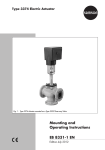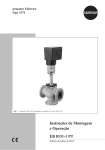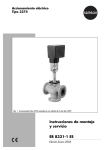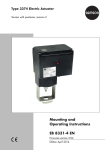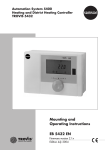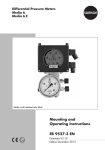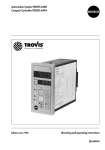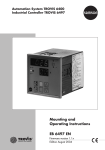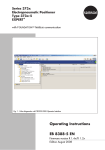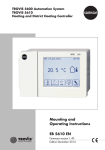Download Samson EB 8331-1 EN Automobile Parts User Manual
Transcript
Electric Actuator Type 3374 Fig. 1 · Type 3374 Actuator mounted on a Type 3535 Three-way Valve Mounting and Operating Instructions EB 8331-1 EN Edition October 2007 Contents Contents Page 1 1.1 1.2 Design and principle of operation . . . . . . . . . . . . . . . . . . . 5 Additional equipment. . . . . . . . . . . . . . . . . . . . . . . . . . 5 Technical data . . . . . . . . . . . . . . . . . . . . . . . . . . . . . 6 2 2.1 2.2 Installation . . . . . . . . . . . . . . . . . . . . . . . . . . . . . . . 8 Mounting position . . . . . . . . . . . . . . . . . . . . . . . . . . . 8 Attachment to the valve . . . . . . . . . . . . . . . . . . . . . . . . . 8 3 Electrical connections . . . . . . . . . . . . . . . . . . . . . . . . . 10 4 4.1 4.2 4.2.1 4.2.2 4.3 Operation and setting . . . . . Manual operation of the actuator Setting the additional equipment . Limit switches . . . . . . . . . . Potentiometers . . . . . . . . . Setting the digital positioner . . . . . . . . . . . . . . . . . . . . . . . . . . . . . . . . . . . . . . . . . . . . . . . . . . . . . . . . . . . . . . . . . . . . . . . . . . . . . . . . . . . . . . . . . . . . . 12 12 12 12 12 14 5 5.1 5.2 5.3 5.3.1 5.3.2 Retrofitting additional electrical equipment Limit switches . . . . . . . . . . . . . . . Potentiometers . . . . . . . . . . . . . . Digital positioner . . . . . . . . . . . . . Calibrating the positioner . . . . . . . . . Simplest method to calibrate the actuator . . . . . . . . . . . . . . . . . . . . . . . . . . . . . . . . . . . . . . . . . . . . . . . . . . . . . . . . . . . . . . . . . . . . . . . . . . . . . . . . . . . . . . 17 18 20 21 22 22 6 Dimensions in mm . . . . . . . . . . . . . . . . . . . . . . . . . . 23 2 EB 8331-1 EN . . . . . . . . . . . . . . . . . . . . . . . . Safety instructions General safety instructions 4 Assembly, start-up and operation of this device may only be performed by 4 4 4 trained and experienced personnel familiar with the product. According to these mounting and operating instructions, trained personnel refers to individuals who are able to judge the work they are assigned to and recognize possible hazards due to their specialized training, their knowledge and experience as well as their knowledge of the applicable standards. Any hazards which could be caused in the connected valve by the process medium, operating pressure or moving parts are to be prevented by means of the appropriate measures. The actuators has been designed for use in electrical power installations. For wiring and maintenance, you are required to observe the relevant safety regulations. The actuator must be protected against unintentional reconnection of the power supply. Take special care when making adjustments on live parts. Do not remove any covers! Proper transportation and storage are assumed. EB 8331-1 EN 3 Note: Actuators with a CE marking fulfill the requirements of the Directives 94/9/EC and 89/336/EEC. The Declaration of Conformity is available on request. 4 EB 8331-1 EN Design and principle of operation 1 Design and principle of operation The Type 3374 Electric Actuator is used in industrial plants as well as in heating, ventilation and air-conditioning systems. The linear actuator is suitable for form-fit attachment to various SAMSON valve series, depending on the version with or without fail-safe action. The actuators consist of a reversible synchronous motor and a maintenance-free planetary gear with ball screw. The synchronous motor is switched off by torque-dependent switches when the final positions are reached or in case of an overload. 1.1 Additional equipment The actuators can be equipped with additional units, such as limit switches and potentiometers, to influence the tasks of control equipment. In addition, the actuator can be equipped with a digital positioner for processing standard signals in the range of 0 (2) to 10 V or 4 (0) to 20 mA. Refer to section 5 for details on retrofitting additional equipment. The motion is transmitted to the actuator stem by the gears and ball screw. Actuator versions with integrated yoke are primarily used for attachment to Series V 2001 Valves, Type 3260 (DN 65 to 150), and Type 3214 (DN 65 to 250) Valves. Actuator versions for central attachment using an M30 x 1.5 ring nut are preferably combined with Series 240 Valves and Type 3214 (DN 125 to 150) . EB 8331-1 EN 5 Design and principle of operation 1.2 Technical data Actuator Type 3374 -10 Version with -11 Yoke Safety function Rated travel -21 -26 -31 -36 Yoke Ring nut Yoke Ring nut Without mm Actuating time for rated travel s Actuating time in case of fail-safe action s Stem extends Stem retracts 30 15 30/15 15 240 120 240/120 120 – 12 2.5 kN Stem extends or retracts Nominal thrust 2 kN Stem extends 0.5 kN Stem retracts 207 V to 253 V; 50 Hz, 90 V to 127 V; 60 Hz or 21.6 V to 27.6 V; 50 Hz (other voltages on request) Power supply Power consumption Without positioner With positioner -15 Ring nut VA 7.5/13 9.5/15 10.5/16 12.5/18 Motor switch-off Torque-dependent Rated temperature range 5 to 60 °C Storage temperature range –20 to +70 °C IP 54 according to IEC 529, (IP 65 with cable glands 1)) Suspended mounting position not approved Degree of protection Overvoltage category II Design and inspection EN 61010 Edition 3.94 Class of protection II Noise immunity EN 50082 Part 2 Noise emission EN 50082 Part 1 Manual override Weight, approx. kg Materials Using hex wrench · Adjustment impossible after fail-safe action has been triggered Manual adjustment of actuators with fail-safe action only possible when supply voltage is applied (see also section 4.1) 3.2 3.3 3.9 4.0 3.5 3.6 Housing and cover made of plastic (PPO glass fiber reinforced) Additional electrical equipment Limit switch Potentiometer 2) 1) 2) 6 Two travel-dependent, adjustable limit switches, perm. load 250 V AC; 3A 0 to 1000 Ω, (0 to 900 Ω at rated travel) max. permissible current 1 mA Cable glands M20 x 1.5 with metal nut, width across flats 23/24 mm Not for version with positioner EB 8331-1 EN Design and principle of operation Digital positioner 1) Input variable 2) Range Operating mode 1 Operating mode 2 Operating mode 3 4...20 mA, Ri = 0.05 kΩ 2...10 V, Ri = 10 kΩ 0...20 mA, Ri = 0.05 kΩ 0...10 V, Ri = 10 kΩ As per settings 3) Resolution Position feedback signal 4) 5) Range 4...20 mA, RB 0.2 ≤ kΩ 2...10 V, RB ≥ 5 kΩ Resolution 0...20 mA, RB ≤ 0.2 kΩ 0...10 V, RB ≥ 5 kΩ Adjustable Setting As per settings 3) 8 Bit Increasing, actuator stem retracts or extends as the input variable increases Characteristic Travel 10 Bit As per settings 3) 6 to 20 mm at 15 mm rated travel 6 to 35 mm at 30 mm rated travel (the travel range between 12 and 35 mm has been extended to between 6 and 35 mm for 30 mm rated travel in positioner version V1.10 and higher) Using travel calibration button (1 mm each time the button is pressed) As per settings 3) using button 1 binary input Electrically isolated, switching voltage 18 to 30 V DC, approx. 7 mA 1 binary output Electrically isolated semiconductor contact, max. 45 V DC, min. 3 V DC, max. 25 mA Integrated interface for SAMSON memory pen /PC Data transmission including settings, operating status and alarms Transfer protocol: SAMSON SSP protocol Retrofittable bus interface On request Total delay time Accuracy Approx. 30 ms ≤ 2.5 % without taking the dead band into account 1) Maximum two current inputs may be switched in series Maximum values ±50 mA or ±25 V 3) SAMSON TROVIS-VIEW Operator Interface software, SAMSON memory pen 4) Can only be taken from current or voltage signal 5) Not when retrofittable interface is used 2) EB 8331-1 EN 7 Installation 2 Installation 2.1 Mounting position Installation depends on the mounting position of the valve. However, do not install the actuator suspended downwards. Note! Manual override is only possible in actuators with fail-safe action when the power supply is connected (see section 4.1). 2.2 Attachment to the valve Series V 2001 (DN 15 to 80), Type 3260 Valves (DN 65 to 150) and Type 3214 Valves (DN 65 to 100) 1. Remove protective covers and unscrew nut (6) from the control valve. 2. Place actuator with yoke onto the valve and fasten with the nut (6, SW 36) using a minimum tightening torque of 150 Nm. If necessary, retract actuator stem slightly beforehand using the manual override. 3. When the plug stem (5) fits closely onto the actuator stem (3), attach both stem connector clamps (4) and fasten with screws. Series 240 1. Push plug stem down to close the valve. 2. Turn coupling nut (8) until a distance of x = 75 mm (x = 90 mm for DN 100 and larger) between the top of the yoke and 8 EB 8331-1 EN 3. 4. 5. 6. the top of the coupling nut (8) is reached. Secure position with lock nut (9). Place actuator onto valve bonnet (2.3) and fasten with ring nut (7). If necessary, retract actuator stem slightly beforehand using the manual override. When the coupling nut (8) fits closely onto the actuator stem, attach both stem connector clamps (4) and screw tight. Move actuator stem (3) to the end position (valve closed) using the manual override or motor. Align travel indicator scale (10) to the middle of the stem connector (4) and screw tight. Type 3214 (DN 125 to 250) 1. Place actuator onto the valve and secure with the ring nut (7). If necessary, retract actuator stem slightly beforehand using the manual override. 2. When the plug stem fits closely onto the actuator stem (3), attach both stem connector clamps (4) and screw tight. 3. Move actuator stem (3) to the end position (valve closed) using the manual override or motor. 4. Align travel indicator scale (10) to the middle of the stem connector (4) and screw tight. Installation Attachment to Series V 2001, Type 3260 DN 65 to 150 and Type 3214 DN 65 to 100 Attachment to Series 240 1 1 2.1 2.3 7 x 3 3 4 8 9 4 5 6 10 5 1 2.2 7 3 10 4 5 Attachment to Type 3214 DN 125 to 250 1 2.1 Actuator Actuator yoke 2.2 2.3 3 4 5 6 7 8 9 10 Valve yoke Bonnet Actuator stem Stem connector Plug stem Nut Ring nut Coupling nut Lock nut Travel indicator scale Fig. 2 · Attachment to the valve EB 8331-1 EN 9 Electrical connections 3 Electrical connections Upon installation of the electric cables, you are required to observe the regulations concerning electrical power installations according to DIN VDE 0100 as well as the regulations of your local power supplier. Establish electrical connections as indicated on the circuit diagram on the actuator cover and as illustrated in Figs. 3 and 4. A maximum of 3 cable glands can be attached to the housing for cable entries. L Ce eL Retracts aL Extends Ce – + N N L aL eL N N L Magnet in version with fail-safe action Limit switches (optional) 41 44 42 51 54 Potentiometer (optional) 52 81 82 a Fig. 3 · Terminal connections, version for three-point stepping signal 10 EB 8331-1 EN 83 91 e 92 e 93 a Electrical connections Caution! 4 Only connect to the main power network 4 Particularly for 24 V, 50 Hz actuators, when the power is switched off. use wires with a sufficiently large cross-section to guarantee that the per4 Only use power interruption devices which ensure that the power cannot be switched on again unintentionally. missible voltage tolerances are not exceeded. Limit switches (optional) 41 44 42 51 54 52 Load, max. 25 mA + mA 31 _ 32 V + V _ mA + + + 33 13 12 11 81 V _ + V _ 82 83 84 N L N L Magnet in version with fail-safe action Position feedback Input Binary input active when voltage is applied Binary output Power supply Fig. 4 · Terminal connections, version with digital positioner EB 8331-1 EN 11 Operation and setting 4 Operation and setting 4.2.1 Limit switches 4.1 Manual operation of the actuator 1. Use motor or manual override to move the control valve to the position where the switching function is to be activated. 2. Use hex wrench to turn spindle (2) for the upper limit switch or spindle (3) for the lower limit switch until the associated contact cam on the cam bracket (7) triggers the switch contact of the upper or lower microswitch (1). To operate the manual override, place 4 mm hex wrench on the red actuator shaft located at the side of the housing. The hex wrench is delivered with the actuator. It is attached to the bottom of the housing. Manual override is only possible in actuators with fail-safe action when the power supply is connected (terminals N and L). Set the selector switch (2, in Fig. 6) of the actuator with positioner to the operating mode 0 = . 4.2 Setting the additional equipment To access the additional equipment, unscrew the four fixing screws on the cover using a Pozidrive PZ2 screwdriver to provide enough hold on the screw heads. Take off the cover. After completing the settings and establishing the electrical connection, refasten the cover. To proceed, place back on the cover and screw the cover screws in slightly to position the cover before tightening them properly. Perform settings while the power is switched on! 12 EB 8331-1 EN 4.2.2 Potentiometers The gears of the potentiometers (12) and (13) must be put onto their shafts to correspond with the rated travel of the control valve. The rated travel inscription “Nennhub 15” or “Nennhub 30” must be legible. If this is not the case, pull each potentiometer gear off the shaft and put it back on again with the reverse side of the wheel facing upwards, ensuring it is aligned roughly flush with the potentiometer shaft. Zero point adjustment 1. Use motor or manual override to move the control valve to the desired end position. 2. Place screwdriver on the slotted potentiometer shaft (12.1 and 13.1). 3. Calibrate potentiometer using the connected ohmmeter correspondingly: Actuator stem extends: 81/82 = 0 Ω ; 91/93 = 0 Ω ; Actuator stem retracts: 81/83 = 0 Ω ; 91/92 = 0 Ω . Operation and setting Limit switch Stem retracts Metal tag Stem extends Rated travel inscription 12 12.1 e 13.1 a N B en n 15 hu b a 13 1 2 3 5 7 12 12.1 13 13.1 1 2 3 7 Microswitch Spindle upwards Spindle downwards Intermediate gear Cam bracket Gear potentiometer 1 Potentiometer shaft Gear potentiometer 2 Potentiometer shaft 5 Fig. 5 · Performing settings EB 8331-1 EN 13 Operation and setting 4.3 Setting the digital positioner In the actuator version with digital positioner, the travel is calibrated automatically, allowing the travel (controlled variable x) and the input signal (reference variable w) of the positioner to be matched in the best possible way. Additionally, the digital positioner provides valve position feedback for remote transmission. Setting and start-up can be carried out using four different operating modes. Operating modes 1 and 2 work with set data stored in the positioner's memory. The user only needs to select the operating mode via the selector switch (2) and press the button (4) to start travel calibration. Note! Setup with operating modes 3 and 0 = can only be performed using a SAMSON memory pen as the storage medium, or in connection with SAMSON's TROVIS-VIEW Configuration and Operator Interface software and a PC or bus system. Setup with operating modes 3 und 0 = is described in Mounting and Operating Instructions EB 8331-2 EN. Settings for operating modes 1 and 2 Increasing characteristic: actuator stem retracts or extends as the reference variable increases. After the actuator has been mounted on the valve as described in section 2.2 and the electrical connections have been established as described in section 3, proceed as follows: 14 EB 8331-1 EN 1. Set selector switch (2) with the arrow pointing to operating mode 0 = (control switched off). 2. Check mounting position of the potentiometer gear (12). The gear must be put onto the potentiometer shaft to correspond with the rated travel of the control valve. The inscription “Nennhub 15” (for 6 to 20 mm travel) or “Nennhub 30” (for 6 to 35 mm travel) must be legible from above on the associated gear side. If this is not the case, pull the gear off the shaft and put it back on again with the reverse side facing upwards, allowing the intermediate gear to engage properly. Note! Actuators with fail-safe action "Actuator stem retracts" or "extends" are only designed for a rated travel of 15 mm. Do not rearrange the gear! Make sure that the shaft of the potentiometer (12.1) is adjusted correctly. 3. Switch on auxiliary power and set the reference variable to a value > 4 mA. 4. Set selector switch (2) with the arrow pointing to operating mode 1 for 4 to 20 mA or 2 to 10 V input and alarm signal, or set it to operating mode 2 for 0 to 20 mA or 0 to 10 V input and alarm signal. 5. Press button (4) to start travel calibration. Operation and setting Press the button briefly to obtain a travel calibration for valve CLOSED when the actuator stem extends. Direction of action: Increasing/increasing. Caution! The automatic travel calibration lasts approximately twice as long as the actuator's transit time. During this period, the valve leaves its current position. Calibrate the travel either on the test bench or when the shut-off valves in the plant are closed. Hold the button pressed for longer than 3 seconds (indicated by switchover from signal lamp 8 to signal lamp 9) to obtain a travel calibration for valve CLOSED when the actuator stem retracts. Direction of action: Increasing/decreasing. After pressing the travel calibration button (4), the actuator stem first moves as far 1 Operating mode 1 2 3 4 5 6 7 Selector switch Operating mode2 Travel calibration button Operating mode 0 Operating mode 3 Potentiometer counterclockwise or clockwise 8 Signal lamp 9 Signal lamp 10 Actuator stem extends and retracts 11 Interface jack 12 Potentiometer gear 12.1 Potentiometer shaft 1 2 3 4 5 6 7 8 SAMSON 2 10 1 3 11 Stellungsregler Positioner Régulateur de position Intermediate gear Intermediate gear Rated travel inscription Intermediate gear 12 B Gear (12) Position for rated travel 15 Gear (12) Position for rated travel 30 9 12.1 Fig. 6 · Selector switch and position of potentiometer gears in version with digital positioner EB 8331-1 EN 15 Operation and setting as it will go to the valve's CLOSED position. Calibration is carried out when both signal lamps (8 and 9) are lit. Travel calibration starts after the mounting position of the potentiometer gear (12) has been determined automatically. This is indicated by signal lamp (8) for 6 to 35 mm travel and by signal lamp (9) for 6 to 20 mm travel. When travel calibration starts, the lower signal lamp (9) blinks quickly for about 10 seconds. The actuator stem retracts as far as it will go (maximum travel - valve OPEN). Travel calibration is successfully completed when the end position is reached. The actuator is in control operation. The actuator stem moves to the valve position determined by the reference variable. Note! If one of the signal lamps starts to blink slowly after the travel calibration button has been pressed and the actuator stem has extended to the valve's CLOSED position, the potentiometer shaft (12.1) has been wrongly positioned. Readjust it manually. 16 EB 8331-1 EN Do not adjust the potentiometer before the closed position is actually reached. This is indicated by the associated, activated limit switch on the board (Fig. 5 on page 13). To proceed, adjust the shaft of the potentiometer (12.1) by turning it gradually clockwise or counterclockwise with a screwdriver until the signal lamp stops blinking and is constantly illuminated. Turn the screwdriver counterclockwise if the upper signal lamp (8) blinks, and clockwise if the lower signal lamp (9) blinks, corresponding to the icons (7). Travel calibration does not continue until both signal lamps are illuminated at the same time. Note! If both signal lamps start to blink simultaneously during travel calibration, interrupt calibration by pressing the travel calibration button (4) and check the mounting position of the potentiometer gear (12) again. If no travel motion can be determined during calibration, e.g. due to a loose or missing potentiometer gear, both signal lamps blink alternately. If this is the case, interrupt travel calibration by pressing the button (4), correct the error, and restart calibration by pressing the button (4) again. Retrofitting additional electrical equipment Setting with limited travel range Travel calibration is usually based on the maximum travel of the control valve. If, however, the maximum possible travel is to be limited to a smaller travel end value, press the button (4) once at the start of calibration while the signal lamp blinks for 10 seconds. As a result, travel calibration via the potentiometer gear with rated travel 15 or 30 is limited to 6 mm. Each time the button is pressed, the travel range is increased by 1 mm. If, for example, a control valve designed for 15 mm is to be operated with a limited travel range of 10 mm, press the button (4) 5 times during the 10 second time limit. The top signal lamp (8) flashes each time the key is pressed. Reporting defined events At the binary output (terminal 83 and 84), predefined events can be indicated (see EB 8331-2 EN) during positioner operation and transmitted to a control room. 5 Retrofitting additional electrical equipment The actuator can be subsequently equipped with two limit switches, two potentiometers or a digital positioner. Depending on the actuator version used, the actuator board needs to be replaced as well. The actuator version is marked on the nameplate, e.g. model 3374-11000002000. When ordering additional electrical equipment from the manufacturer, make sure to include this model number in the order. Caution! When installing electrical equipment, make sure the supply voltage and the signal input are disconnected. Only use power interruption devices which are protected against unintentional reconnection of the power supply. Note! It is recommendable to slightly apply lubricant (e.g. Vaseline) to the spindles on the gear faces and to the sides of the cogs. EB 8331-1 EN 17 Retrofitting additional electrical equipment 5.1 Limit switches The retrofit kit (order no. 1400-8830) is required to install limit switches. If the actuator is not already equipped with potentiometers or a positioner, the basic unit (order no. 1400-8829) is also required. The unit includes the spindle gear (2) and the intermediate gear (5). Note! To mount the limit switches, the actuator stem must be in end position, i.e. the stem must be either fully extended or fully retracted. If necessary, move the stem to the appropriate position using the manual override on the side. 1. Remove the fastening screws. Push the actuator board (1) from its guiding to the right. Slightly lift the board and continue pushing it further towards the cable entry. 2. Clip the spindle gear (2) onto the sleeve (3). Make sure the lateral latch is properly engaged in the groove of the sleeve. 3. Plug intermediate gear (5) onto the spindle (4). Place the serrated ring (10) on top and push it down until it will not go any further. 4. Plug both premounted contact cams (6) with the ring gear first onto the cam bracket (7). 5. Push adjustment gears (8) onto their spindles and fasten with one screw each. Check whether the adjustment screws can be turned easily. If not, slightly loosen the screw again. 18 EB 8331-1 EN 6. Turn both contact cams (6) as illustrated in Fig. 7.1 corresponding with the position of the actuator stem on the cam bracket (7). 7. Push the spacer (9) onto the spindle for the cam bracket. Push the cam bracket with both cams onto the spindle corresponding with the position of the actuator stem as illustrated in Fig. 7.2. Make sure that the outermost cog of the cam bracket (7) engages in the gearwheel of the intermediate gear (5). In addition, the adjustment gears (8) must engage properly in the corresponding gears of the contact cams (6). 8. Secure the cam bracket (7) and intermediate gear (5) with the serrated ring (10), pushing the ring down until it will not go any further. 9. Position the terminal board (11) at the base of the support at a 45° angle (approx.) with the switches facing towards the gears. Push the upper end of the terminal board towards the gears until the board is in a vertical position and properly engaged in the support. 10. Push the actuator board (1) back into its guiding. Make sure that the gears are properly engaged. Fasten the board using screws. Adjust limit switches as described in section 4.2.1. 4 Retrofitting additional electrical equipment 1 Actuator board 9 Spacer 2 3 Spindle gear Sleeve 10 Serrated ring 11 4 Spindle Terminal board with microswitches 5 6 Intermediate gear Contact cam 12 Gear in version with potentiometer 7 Cam bracket 8 Adjustment gear 7.1 Position of the contact cams (6) on the cam bracket (7) 8 9 5 4 3 2 1 7 12 6 6 For actuator stem retracts extends 7.2 Position of the cam bracket (7) 5 7 11 12 10 B 8 7 For actuator stem retracts For actuator stem extends B 5 2 Fig. 7 · Retrofitting limit switches, in this example model 3374-11000002000, version with potentiometers EB 8331-1 EN 19 Retrofitting additional electrical equipment 5.2 Potentiometers Actuators with a digital positioner cannot be equipped with potentiometers. To install the potentiometers, an actuator board with the appropriate potentiometers and gears (12 and 13) is required. If the actuator is not already equipped with limit switches, the basic unit (order no. 1400-8829) is also required. The unit includes the spindle gear (2) and the intermediate gear (5). 1. Remove the fastening screws. Push the actuator board (1) from its guiding to the right. Take out the board and replace it with a board with potentiometers. 2. Clip the spindle gear (2) onto the sleeve (3) as illustrated in Fig. 7, top. Make 1 2 5 10 10 Actuator board 12 Contact cam Intermediate gear 13 5 2 Serrated ring Gear potentiometer 1 Gear potentiometer 2 13 Fig. 8 · Version with potentiometer 20 EB 8331-1 EN 12 1 sure the lateral latch is properly engaged in the groove of the sleeve. 3. Plug intermediate gear (5) onto the spindle (4). Place the serrated ring (10) on top and push it down until it will not go any further. 4. The potentiometer gears (12 and 13) with retaining rings must be put onto their shafts corresponding with the rated travel of the control valve. The rated travel inscription “Nennhub 15” (on the upper side with the retaining ring) or “Nennhub 30” (lower side) must be legible from above (also see Figs. 4 and 5). 5. Push the actuator board back into its guiding. Make sure that the gears are properly engaged. Fasten the board using screws. Adjust the potentiometer as described in section 4.2.2. 4 Retrofitting additional electrical equipment 5.3 Digital positioner To install a positioner, a corresponding actuator board and TROVIS-VIEW 3374 and connecting cable 0450-1978 are necessary. If the actuator is not already equipped with limit switches, the basic unit (order no. 1400-8829) is also required. The unit includes the spindle gear (2) and the intermediate gear (5). 5 Intermediate gear 6 7 Contact cam Cam bracket Note! Actuators with a digital positioner cannot be equipped with a potentiometer. 8 Adjustment gears 10 Serrated ring 1. Remove the fastening screws. Push the actuator board (1) from its guiding to the right. Take out the board and replace it with a board with positioner. 2. Clip the spindle gear (2) onto the sleeve (3) as illustrated in Fig. 7, top. Make sure the lateral latch is properly engaged in the groove of the sleeve. 3. Plug intermediate gear (5) onto the spindle (4). Place the serrated ring (10) on top and push it down until it will not go any further. 4. The gear (12) on the feedback potentiometer, which is equipped with a retaining ring, must be put onto its shaft corresponding with the rated travel of the control valve. The rated travel inscription “Nennhub 15” (on the upper side with the retaining ring) or “Nennhub 30” (lower side) must be legible from above (also see Figs. 4 and 5). 5. Push the actuator board (1) back into its guiding. Make sure that the gears are properly engaged. Fasten the board using screws. 12 Gear feedback potentiometer 8 7 5 10 12 Fig. 9 · Version with positioner without (top) and with (bottom) limit switches EB 8331-1 EN 21 Retrofitting additional electrical equipment 5.3.1 Calibrating the positioner To calibrate the positioner, proceed as described in section 4 of EB 8331-2 EN. 5.3.2 Simplest method to calibrate the actuator If tools such as the TROVIS-VIEW software, PC etc. are not available for calibration of the actuator and the actuator operation with maximum precision is not necessary, the simplest calibration method can be performed as follows: 1. Position the selector switch (2) to operating mode 0 = . 2. Press down the travel calibration button (5) for at least 15 seconds until both signal lamps light up. 3. Release the button to start calibration. The actuator stem extends until the torque-dependent switches switch off the actuator. The position of the potentiometer is checked. 4. Re-adjust the potentiometer, if necessary, while observing the signal lamps. Refer to the description given on page 14 of EB 8331-2 EN. After adjusting the potentiometer, the calibration of the actuator is continued. 22 EB 8331-1 EN 4 Mount the actuator on the valve and set the positioner as described in section 4.3 of these instructions. Dimensions in mm Dimensions in mm Version with yoke Version with ring nut 193 120 30 (15) Stem connector 90 (75) 15 (30) 294 204 60 50 6 EB 8331-1 EN 23 EB 8331-1 EN S/Z 2007-10 SAMSON AG · MESS- UND REGELTECHNIK Weismüllerstraße 3 · 60314 Frankfurt am Main · Germany Phone: +49 69 4009-0 · Fax: +49 69 4009-1507 Internet: http://www.samson.de
























